The Green Twig Murder: Is the Unsolved Slaying of a Los Angeles Woman Tied to the Infamous Black Dahlia Case?
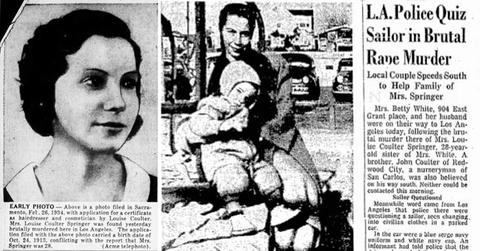
Feb. 16 2024, Published 2:01 p.m. ET
Some crimes are simple. Somebody might shoot another person in a fit of anger or during a robbery. Others are driven by sex or mental illness.
Then there are complicated intrigues, rabbit holes where thousands of clues and statements can threaten to overwhelm police.
Yet more appear simple on the surface but have hidden depths and intrigue. Often with little evidence to be found, it could be said that these types of murders offer the most formidable challenge for investigators to solve. One such crime was the kidnapping and brutal slaying of Louise Springer.
An attractive stylist, Springer seemingly didn't have a single enemy in the world. Yet, one summer's night in LA, she would be gruesomely killed in a murder that some link to the Black Dahlia's even more horrific death two years earlier.
WHO WAS LOUISE SPRINGER?
There was seemingly no reason for 36-year-old Springer to disappear. She enjoyed both a happy home life alongside her husband and 21-month-old son and equally enjoyed her job as a hairstylist.
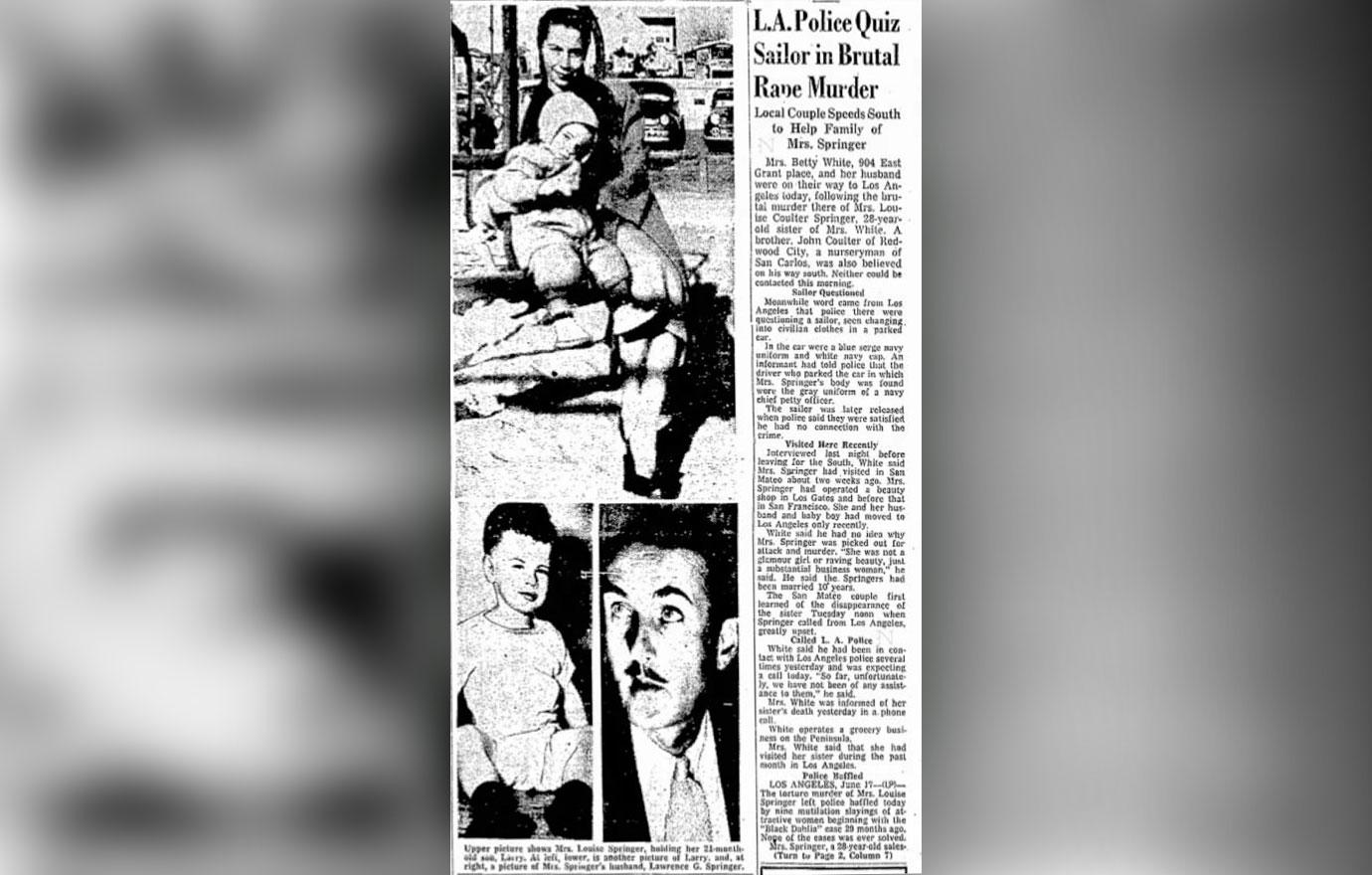
The couple sold the beauty shops they'd owned in San Francisco, Redwood, Santa Barbara, and Los Gatos and moved to Los Angeles six months before she vanished. They were said to be enjoying life in their new home, having enough money to live comfortably. With the money from the sales, the family bought a new 1948 Studebaker convertible, a car that would become one of the era's classics.
Springer often worked late nights; however, on June 13, 1949, she decided to head home a little early. It was around 9 p.m. when her husband Laurence Springer arrived to pick-up his wife at the beauty shop where they worked in Crenshaw.
He parked at a lot across the street. Entering their car, Louise seemed exhausted and pulled off her shoes, replacing them with slippers she kept in the vehicle. She soon realized she forgot her glasses, and Laurence chivalrously offered to go and get them. He retrieved the glasses and fatefully stopped to buy a magazine and cigarettes, spending a few moments chatting with a friend.
When he returned to the parking lot just ten minutes later, both his car and wife were gone.
Laurence looked around and sought the help of an attendant, becoming increasingly frantic as he realized his wife was nowhere to be found. At 10 p.m., the husband called the police and was soon joined by a patrol car who assisted in a new search of the parking lot and nearby streets. From the beginning, Laurence stated he was fearful of foul play. Nothing was found, and Laurence attempted to file a missing persons’ report at the University Division police station, being told he would have to wait for 24-hours. He returned home.
On June 16, police were called to a routine report of over-parking on 38th Street, a quiet residential location a few miles away. Running the plate, police soon discovered the vehicle was the one reported missing from Crenshaw on Monday night. The windows were down, but the top was up. Sgt. Edward Holmes of the missing persons unit was notified, and soon enough, he sent two officers to the scene.
Investigating, one of the officers saw a tarp on the backseat. Moving it aside, he discovered the decomposing body of Louise Springer. The car was parked there just about an hour after Springer went missing on June 13. Police drove the vehicle to the morgue, the body remaining in the backseat.
MURDER REACTION
Louise was garroted with a length of clothesline, the killer looping it around the neck and utilizing such force that the loop's diameter was just two-and-a-half inches.
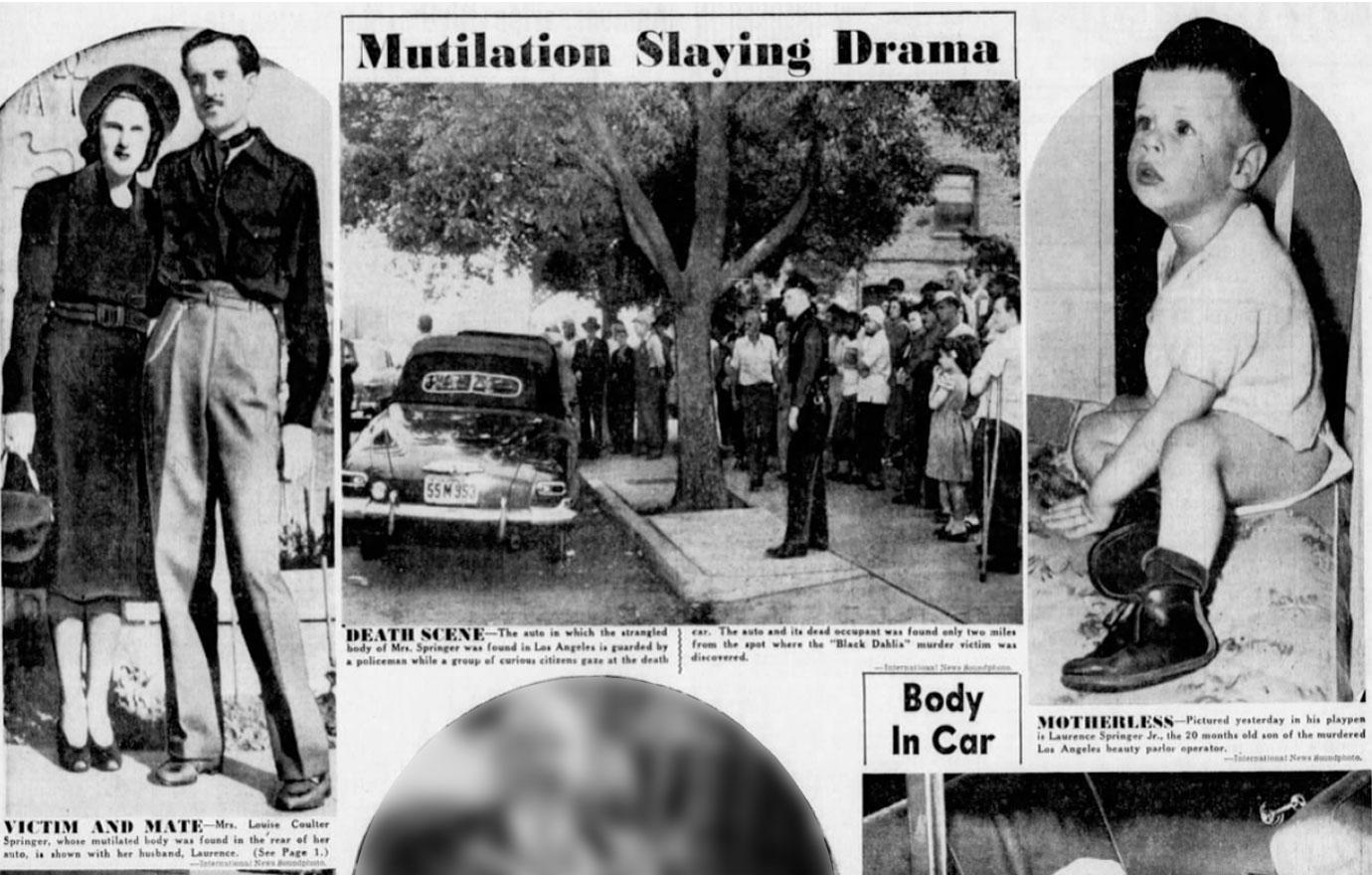
Louise's face and torso had gone black, and a 14-inch stick was forced into her vagina postmortem. Some accounts say the twig had been inserted with such force it had been "thrust through the lower part of her body."
The victim's clothes were in disarray, with her skirt being tangled up around her hips and her jacket twisted around her body.
There was no sign of struggle in the car; there had been no report of screams, and police noted that her manicure was still immaculate with no sign of any defense. All of her jewelry was still present, ruling out robbery as a motive, which was unusual as almost all carjackings in the area were for that reason.
Police hypothesized she had either been immediately stunned when an assailant had entered the vehicle, or she knew her killer and was surprised. As a convertible and the middle of June, the roof might have been down, making access very easy. It was a brazen attack.
The L.A. press reaction was immediate. Already noted for their sensationalist and alarmist nature, the brutal killing immediately invoked memories of the Black Dahlia, Elizabeth Short, killed in January of 1947. The car seemingly vanished from a parking lot in Crenshaw, just five blocks from 39th and Norton, where the mutilated and bisected body of Short was found in 1947.
While Louise Springer was also still relatively young and certainly both attractive and brunette, this is as far as any links between the killings go.
Like almost every murder of a woman in Los Angeles during this era, the press speculated it was the work of a serial killer, often thanks to unfounded claims from the LAPD themselves. It's worth noting that at this time, the force was under investigation for its failings in many unsolved cases.
The latest killing sent the media into a frenzy and attempts to link the murders continue to this day. Yet, most investigators believe that Short was killed by somebody known to her and who had held a personal grudge, her body showing extensive signs of torture and personal humiliation. Likewise, Short's body was posed and displayed, and her killer showed extensive attempts to cover-up his crime, the motivation being sexual.
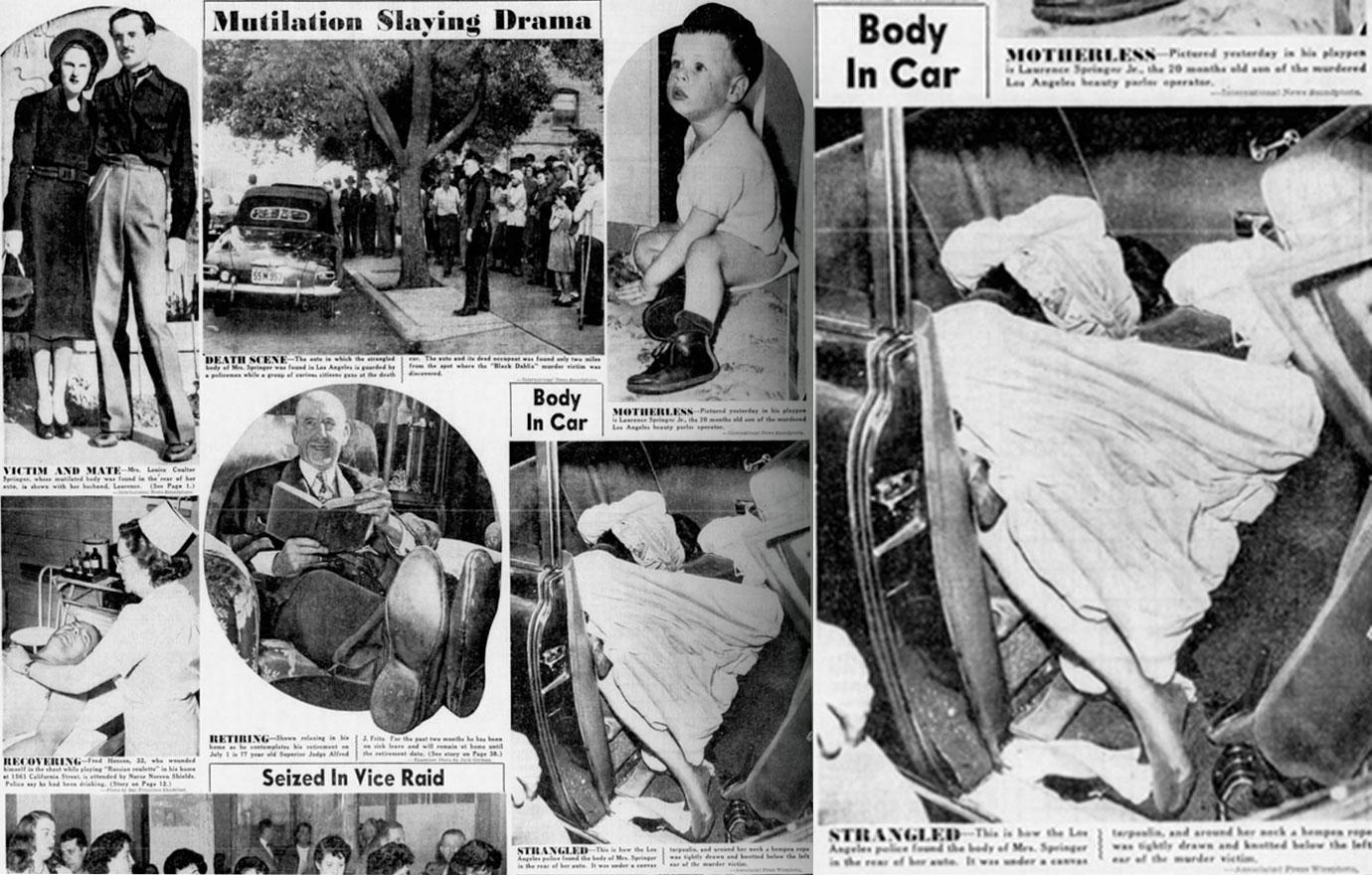
While Louise was killed by a random maniac on the face of things, investigations at the Springer home would raise an interesting red flag.
Speaking with the family housekeeper and nanny Elizabeth Thompson, police discovered that three months before the killing, Thompson answered the phone to a mysterious woman. The nature of the call was obscene, and when Thompson asked the woman to identify herself, the caller made an indecent proposal.
Disgusted, Thompson hung-up the phone. The call took place in the evening when Louise was usually out of the house. Thompson would tell police the Springers were a happy couple, and she wasn't aware of anyone who might wish to do Louise harm. However, having only moved to Los Angeles six months ago, the couple recently placed their house on the market for sale. The impressive eight-bedroom hillside home was built in the Spanish style, and there had been an "open house" the previous week.
- Hollywood Film Noir Mystery: A Young Starlet Went to a Night Shoot for a New Movie — Then Vanished Forever
- Two High School Grads and a Mom Vanished with Few Clues. A Missouri Town Is Still Stumped About What Happened to Them.
- Catching the Chameleon: How 3 Women Unraveled the Bear Brook Serial Killer Mystery (FPD Case Vault)
Thompson was unsure how much interest there had been in the property and had been away at the time, being unable to comment on whether any suspicious visitors had visited the house. Despite the dubious nature of the call, police eventually ruled out any link with the killing of Springer.
During their search of the Springer’s car, police found a pair of glasses shoved inside a pair of gloves. Laurence explained that his wife wore two pairs, one for work and one for driving. However, while Laurence stated his wife could drive, explaining the glasses, both neighbors and Thompson didn't know whether Louise could. This would be somewhat peculiar as Thompson had known Louise for 10-years since they were neighbors in San Jose.
NUMEROUS SUSPECTS
One line of inquiry was that a jealous ex-boyfriend might have been involved in the slaying, with police traveling to San Francisco for an entire week to carry out investigations as to whether somebody in Louise's past may be connected to the affair.
Over the week before the kidnapping and murder, a man had called her place of work six times inquiring for her, quickly hanging up. The press hinted that she might have been having an affair, although how much of that was simply invented scandal is open to debate.
Witnesses in the neighborhood where the car was dumped described a man who sat inside on the night of the killing. They said they had seen him moving something in the back seat, and some suggested he had been wearing a military uniform. Don Graham, who lived just 50 yards from where the car was dumped, described the uniform as grey and said he was wearing a naval cap.
The witness stated that the suspect was black-haired and had left the car at some point between 10 and 11 p.m. Other witnesses from the area claimed they saw three men in a dark vehicle two nights before the murder. They parked near where the car would eventually be dumped. The lead failed to pan out, and there seemed to be few new ones until the sudden arrest of two suspects a week later.
Leon Russell was a car washer who worked at a gas station not far from the parking lot where Louise Springer had seemingly been kidnapped. His friend, Claude Roscoe Cox, was a Navy veteran who was currently unemployed. Cox was the more likely suspect of the pair, having already been arrested on an accusation of attempted rape. Marion Brown, 18, accused Cox of taking her to his room and trying to rape her. Cox admitted he had been there and overly familiar with the woman but denied any rape attempt.
Both men were released, but Cox would soon come to police attention again in September when another individual made an accusation against him. Geneva Cowen, 35, had been minding her own business as she walked down Hollywood Boulevard when she heard a man behind her. Turning, she had no time to react before Cox punched her, yelling, "I'm going to kill you." Cowen ran for her life, narrowly escaping when Cox grabbed her coat and pulled it off.
Meanwhile, forensics initially ascertained that bruising to the head would have been enough to render Louise unconscious, perhaps supporting the theory that she was assaulted by a stranger rather than surprised by a killer she knew.
This was soon proven false, and the bruising had instead been typical tissue damage associated with the position of the corpse in the car. The evidence suggested Louise was already dead before the car left the parking lot. However, the car's starter was unusually underneath the gas pedal, meaning the killer would have needed to know that fact before he killed Louise and fled.
Equally, police speculation included the possibility the killer was hidden crouched on the car's floor behind the front passenger seat. It is hard to see how this would be possible unless Laurence Springer brought the killer with him. While it might immediately seem unlikely somebody could successfully hide in the car, there is the possibility they could have been hidden under the same sheet that would eventually cover Louise's body. This sheet was a beautician's tarp that Louise always kept in the car, and it wouldn't have raised her suspicions.
Meanwhile, tests for sexual assault came back inconclusive due to decomposition. The attempts to identify the stick used to penetrate the corpse also proved problematic, with experts eventually ascertaining it came from a bottlebrush tree.
It was broken off a larger branch sometime over the past year. These trees are frequently seen throughout L.A., and some accounts place overt importance on the clue, press at the time having mistakenly attributed the stick to the bottle tree, which is not native to the United States.
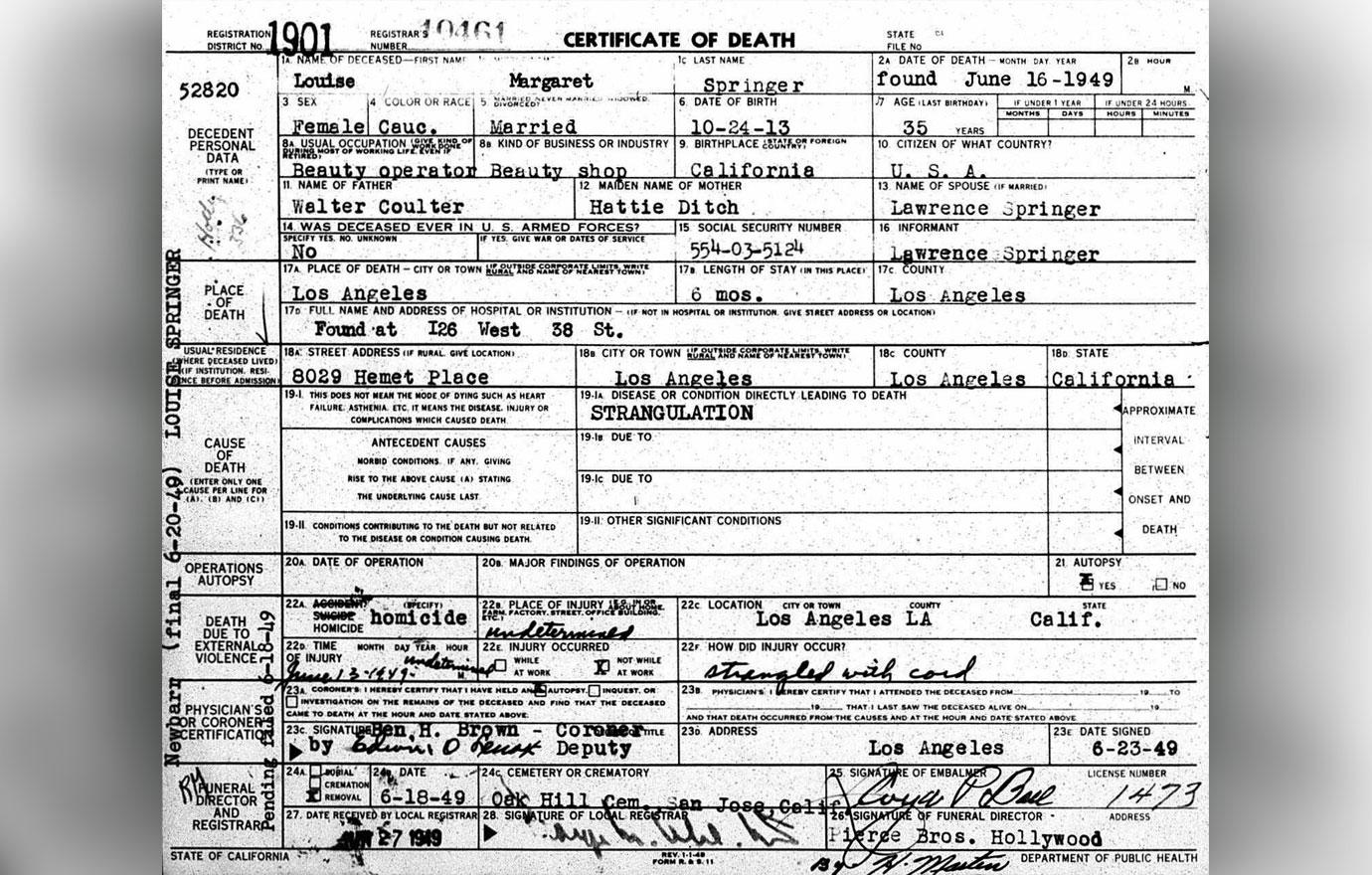
There would be other suspects in the case, including Guy Smith, who his own family accused of involvement in the killing, and Ralph Kyle, who was picked up when officers spotted him changing out of a navy uniform inside a car. Investigating the vehicle, police found a length of clothesline in the trunk.
Kyle, a former submariner, was held for four hours as police ascertained he was in the Navy Reserve and currently living in the vehicle. Kyle stated he simply liked wearing the uniform, and the clothesline would soon be found to be a different type to the murder weapon.
After a check of his movements on the night of the murder, he was released, but not before his distraught mother arrived at the station. Irene Kyle reported her son as a missing person back in April, and upon seeing him, she collapsed. Taken to the captain's office while she recovered her composure and Kyle explained himself. The "moody" 23-year-old told police he had wanted to live his own life. Reunited, Kyle went home with his mother.
While the footnote on Kyle and Irene would have made a nice ending to the case, unfortunately, nobody would ever be charged for the murder of Louise Springer. Despite the largest LAPD manhunt since the death of the Black Dahlia, the trail had gone cold.
NO ANSWERS
If an assailant entered Louise Springer's vehicle, likely with the roof down, it would be an outrageously confident attack. While sundown had occurred at 7:05 p.m., the parking lot was well lit and directly opposite a shopping center and many businesses. The likelihood that the killer could be spotted or the husband would return to the car was immense.
The presence of the titular "green twig" also intrigues. Louise Springer's body showed no evidence she had ever left the vehicle, and eyewitnesses at the dumpsite suggest that he didn't return once the culprit fled the car. Did the killer stop somewhere on the way? Or had the utilization of the stick been preplanned and something he had in his possession when he entered the vehicle?
We will likely never know.
The year 1949 was not a good one for the LAPD. As they sought the killer of Louise Springer, a grand jury was at work investigating their failings in all manner of other murders and missing women, including Short, Georgette Bauerdorf, and Mimi Boomhower.
Louise would soon be added to that list. The jury's findings were devastating, revealing that internal infighting and corruption were rife, the police allowing all manner of shady characters to operate with impunity.
That said, Louise’s killing seems to be a case where there simply wasn't enough evidence to proceed further, with no suspect raising enough alarms to be considered interesting and perhaps the real motives behind the crime remained hidden.
The murder of Louise Springer would be yet another affair where Los Angeles failed to find justice, the terrible case remaining unsolved.
Become a Front Page Detective
Sign up to receive breaking
Front Page Detectives
news and exclusive investigations.
